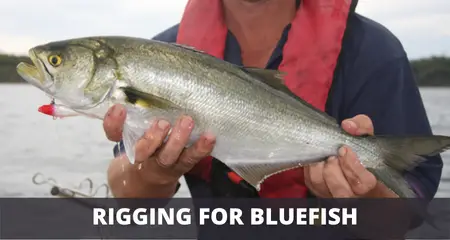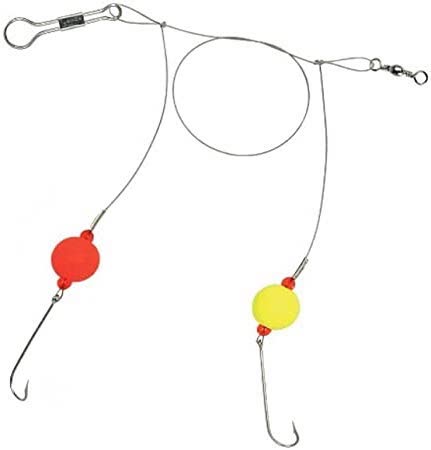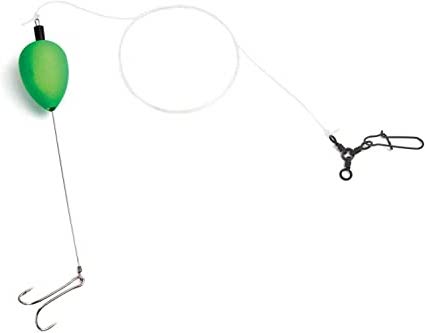Rigging For Bluefish (3 Rigs You Need To Know)
UPDATED 03 NOVEMBER 2023
by Robert Ceran
Big bluefish are like eating machines that slash, crash, swim, and eat. Coastal fishermen call a bluefish feeding frenzy a “blitz.”
During a blitz, bluefish often eat any unlucky baitfish they come across, and if an angler is in the right place at the right time, any fishing lure or bait that is thrown into the chaos will be eaten right away.
In the past 10 years, bluefish numbers have unfortunately been going down, but they recently had a few good years along the Outer Banks, which gives me hope for the future.

After fishing along the Atlantic Coast for decades, I’ve been lucky enough to experience a few of these wild blitzes, but I know that it’s not always catch-’em-on-every-cast blitz fishing.
In fact, big blues sometimes turn down almost everything, and it can take a long time to catch them.
And even though that doesn’t happen very often, there are a few rigs and baits that coastal veterans use who always catch fish when others don’t.
How to rig for bluefish
What are the best rigs for catching big bluefish in the surf near the beach, inlets, and rock jetties?
If you ask a dozen fishermen, you might get twelve different answers, but the best bluefish rigs all have in common that they come with bright colors and movement.
Even if dead bait is on the bottom of a rig, a small cork or plastic foam float that rides right in front of the hook will do the trick.
Different names for these rigs include “doodlebugs,” “bait bugs,” and “fireballs.”
Fireball rig
Two-hook fireballs are mostly used to catch small blues, and they work well for fish from 1/2 to 4 pounds. They are set up in a high/low way, with a snap for the sinker at the bottom of the rig.

Sizes of hooks can be anywhere from 2 to 2/0. A company in North Carolina called Sea Striker makes a mini fireball rig with gold hooks that I like to use for small blues.
When baited with pieces of fresh shrimp, this fishing rig is also great for pompano and whiting.
Big fireball rigs are for jumbo blues, which are big brutes that can weigh up to 15 pounds. They have big 7/0 hooks, a big float, and a nylon-coated steel cable leader.
On one eye of a triple swivel rig, the leader is crimped, and another eye has a sinker clip.
Mullet rig
A mullet rig is a variation on the fireball theme that is mostly used when finger mullet are swimming near the shore.

The mullet rig is made up of a single strand of bluefish-proof wire that goes all the way through the baitfish. A double-barbed hook is attached to the wire near the bait’s tail.
This setup catches bluefish by surprise when they try to bite the tail off a small, whole finger mullet. A small float rides right in front of the hook, drawing attention to it.
Fish finder rig
Some coastal anglers prefer a fish finder rig with a sliding sinker for blues.
But keep in mind that this isn’t a magic device that finds a school of fish for you. Instead, it’s a rig that lets the sinker, which is attached to a small plastic sleeve, move freely along the line.
Fish finder rigs work best when bluefish are hesitant to eat or when the surf is rough enough to require too much weight, which could scare a fish away when it picks up bait on the bottom.
The fisherman’s line goes straight to the bait, so a bluefish can take it without feeling the weight.
Always use sharp hooks for your bluefish rigs
Bluefish are caught on sharp hooks. So no matter what rig you use for blues, make sure the hooks are always sharp.
I usually use a sharpening stone or file on every hook before I put it in the water. You can do this at home, but it’s also good to have that option when you’re on the water.
I also check my hooks every now and then while I’m fishing, to make sure they’re still sharp.
Hooks get a lot of punishment in the surf, and their points are regularly banged into rocks and other hard objects.
What bait should you use for bluefish?
All of the rigs in this article are fished with pieces of fresh fish, which are generally called “cut bait.”
However, each local area may have a favorite bait fish that is used there. The best way to find out what people in your area use is to go to a coastal tackle shop and ask.
Mullet (sometimes called “jumping mullet”), can be found in the waters of every Atlantic coastal state and in the Gulf of Mexico.
Mullet are the main food for many fish that eat other fish. The meat of a mullet is greasy, and the skin is as tough as leather.
Small finger mullet, “corncobs,” and full-grown fish that can weigh several pounds can all be used as bait.
I always scale and filet the big mullet. I take off the scales so that a hook can go through the baits more easily.
Small finger mullet can be chunked, stripped, fileted, or used whole on rigs made for that purpose.
Menhaden or herring are deadly baits that are popular in some coastal areas. However, their flesh and scales are soft, so they need to be cooked differently than mullet.
I never scale and rarely filet menhaden. You can cut these baits into steaks or chunks.
Don’t try to hide the hook point with any bait. A much better way to hook a fish is with a barb that sticks out.
Check your bait often, to make sure it’s still fresh
It is very important to check baits often and switch them out. Bluefish, like people, like to eat food that not only looks good but also smells good.
Old bait that has been washed out by the waves won’t bring in much more than crabs. More than once, I’ve had bluefish bite right after a fresh bait hits the water and sinks to the bottom.
So use bait that is fresh and has not been frozen, brined, or pickled. Fresh bait looks and smells right, and it stays on the hook better than anything else.
Finally, keep your baits cold and surrounded by ice. Don’t let them sit in water at the bottom of a cooler.
